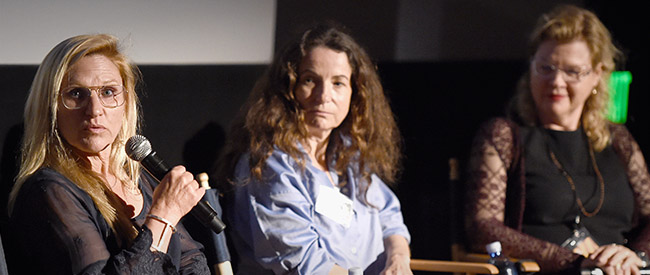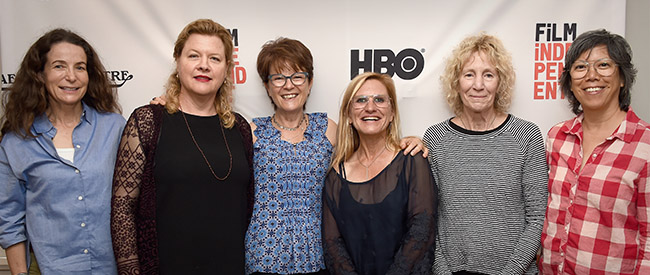It’s a rare opportunity to assemble this much talent in one place. The panelists included: Maryse Alberti, best known for her work on Happiness, The Wrester and Creed, as well as this year’s recipient of the 2016 Glory to the Filmmaker award; Joan Churchill, the first documentary filmmaker to be accepted into the American Society of Cinematographers (ASC); Amy Vincent, who shot Lemony Snicket’s A Series of Unfortunate Events, Black Snake Moan, and who given an award by the Sundance Film Festival in 2005 for her work on Hustle & Flow; and Tami Reiker, who I personally took note of for her amazing work on High Art, and who was the first woman to earn the ASC Outstanding Achievement in Cinematography Award for her work on the pilot of the original HBO series Carnivàle. Also in attendance was Mandy Walker, cinematographer of the third-highest grossing Australian film of all time, Australia. Moderator Patti Lee is yet another outstanding female DP with a long list of TV credits, including The Bernie Mac Show (FOX) and the nonfiction feature A Small Act, which the late Roger Ebert named as one of the best documentaries of 2010. Taken together the panelist’s wide-ranging body of work covers practically the entire spectrum of filmmaking—from small budget docs, to independent films, to television, to major $100 million plus blockbusters. The awards these women have garnered over the course of their careers are far too lengthy to include here. But even with all of the honors and awards represented by just these six women alone, female cinematographers still struggle for recognition and opportunity. But in an industry made up overwhelmingly of men, these women provide a shining example of female artists who have overcome (or outright ignored) the typical barriers to entry. Nearly every one of the panelists had a story about someone coming up to them on set and saying something like, “Wow! You’re the first female cinematographer I’ve every worked with”—most admitted that it was usually moments like this that would remind them just how rare of a breed they actually are. Which isn’t to say the panelists lacked an awareness of the ongoing inequality—much the opposite. The panelists expressed the idea thusly: “True change is going to come about by each one of us taking another woman, another person of color, another unheard voice and helping them make their movie.” Vincent, for instance, divides her time between the film set and the classroom, teaching cinematography and filmmaking and Walker and Reiker have provided internship opportunities for women to shadow them on their sets. The panel expressed hope that with all the talk happening these days about opportunity that they would see significant change in Hollywood soon. To wrap up, here now are 10 key observations, anecdotes and pieces of advice gleaned from the panelists:
In the documentary world, “You float, you learn to react with instinct, to work with very simple tools. You learn movement. You learn to go into a room and know where to put the camera. Fast. In [narrative filmmaking] it’s a bit more of an intellectual process. You have a lot of time to prep and to think, to choose the style.” – Maryse Alberti
There are “Two different worlds. The documentary cameraperson has a different set of skills. And mostly it’s people skills. You have to be able to listen and anticipate what’s going to happen. And you also have to be the kind of person who is genuinely interested in other people.” – Joan Churchill
“You make the movie of your dreams in your head, but then reality hits.” – Tami Reiker
Working on Australia presented some unique challenges, like having to match footage that was sometimes shot six months apart. But luckily with a large budget, “I had a still photographer with me and I took photos of everything I did. [I] wrote meticulous notes, so when we were shooting something later I knew exactly what my exposures were and my ratios and the color of the light.” – Mandy Walker
“If I were to give some encouragement to the young women coming up, have strength in your collaboration with your director and have the technical foundation in all the equipment and color science. Have that down so you can stand with confidence on set.” – Amy Vincent
“Know what the director wants. Then, when everything goes wrong, you’re together. So much of [filmmaking] problem solving in the moment. And you’re a problem solver.” – Tami Reiker
“Read the script, re-read the script and re-re-read the script. Understand who the director is and what his vision is.” – Maryse Alberti
“You must reconcile budgets in the prep and be an advisor and collaborator with the director. Balance the movie of your dreams with the vision of the director with realities of how many days you can schedule. It’s all about communication. Keeping your director close and keeping your producers closer so that you can facilitate.” – Amy Vincent
“I’m certainly affected by what I’m shooting, and it changes my style. But kind of unconsciously.” – Joan Churchill
“As a cinematographer one of the most important things is to shoot with intention and do your homework. (Because) you are in charge of helping establish a mood for the film.” – Patti Lee
LA Film Festival’s Women Behind the Lens: Spotlight on Cinematographers is sponsored by Jaeger-LeCoultre, HBO and the Loyola Marymount University School of Film and Television.
This year’s 2016 LA Film Festival is currently happening at the ArcLight Cinemas in Culver City as additional venues citywide through June 9. Buy your tickets to all of our great screenings and special events today. Click here for more information. To see our full lineup and Festival Guide, please visit our website, stay tuned to this blog and subscribe to our YouTube channel. Learn how to become a Member of Film Independent by clicking here.

